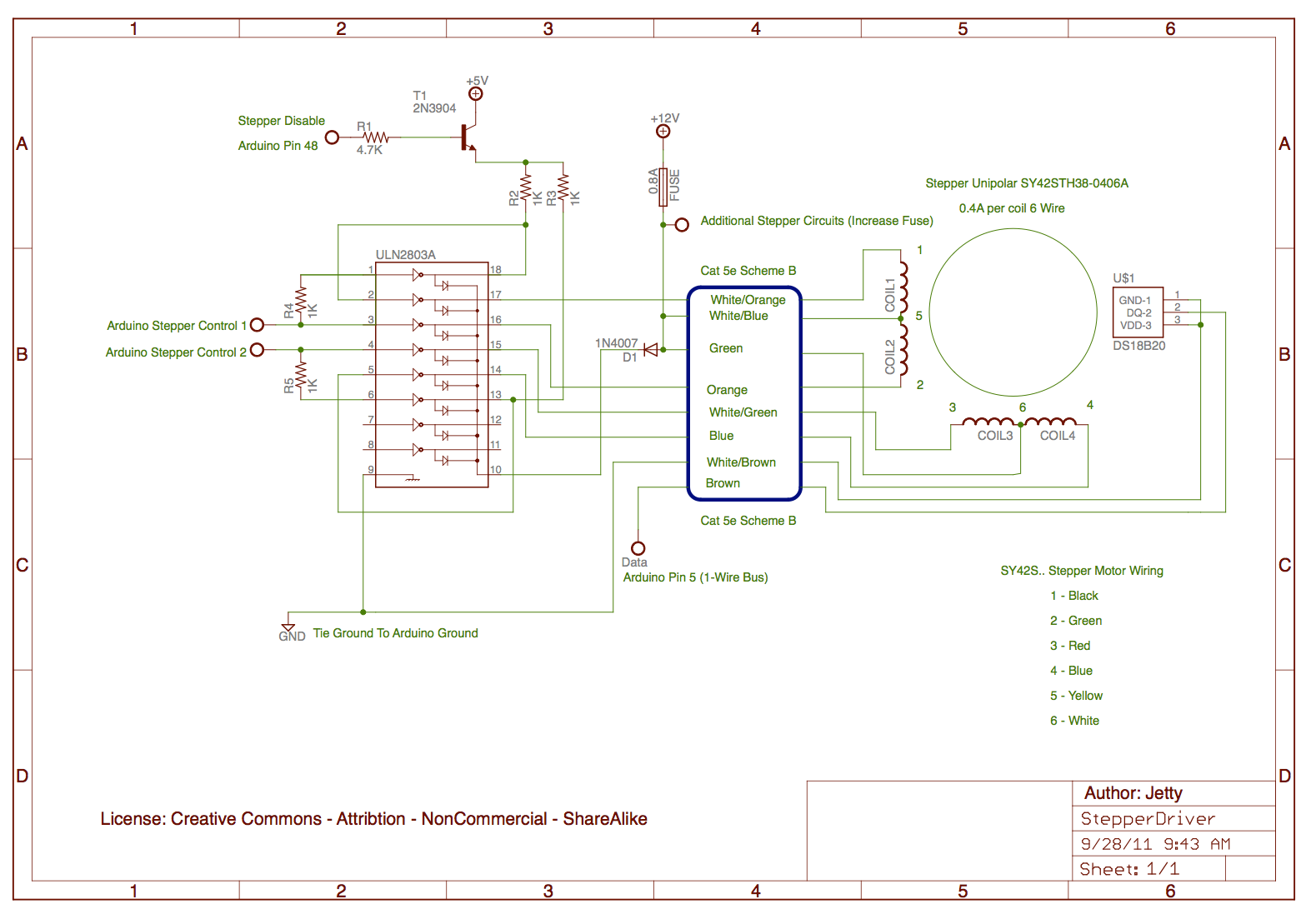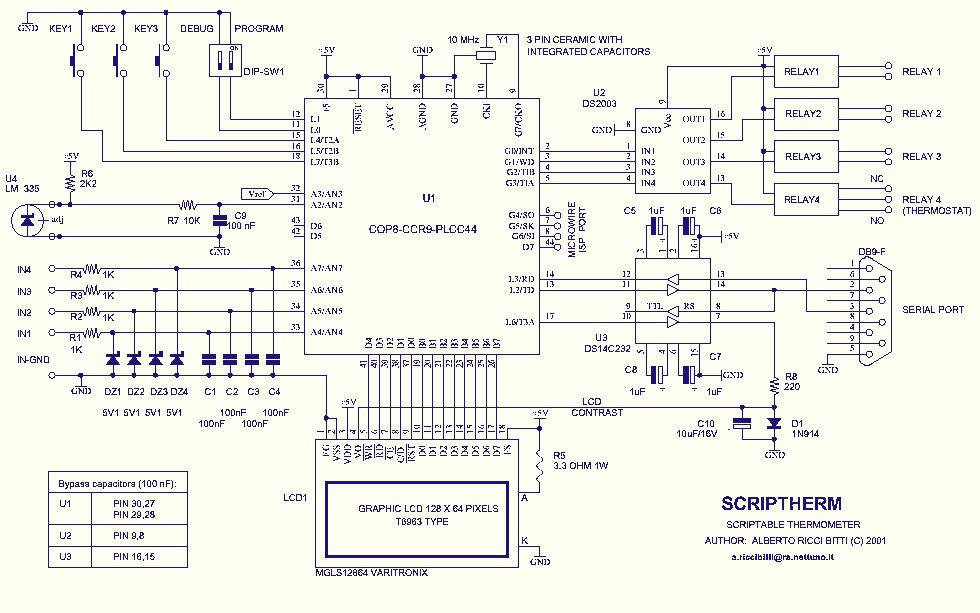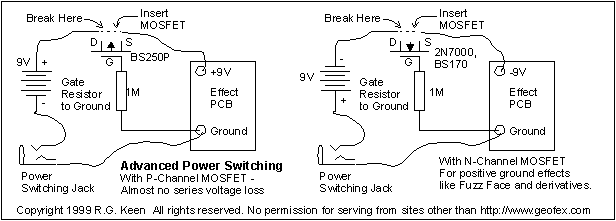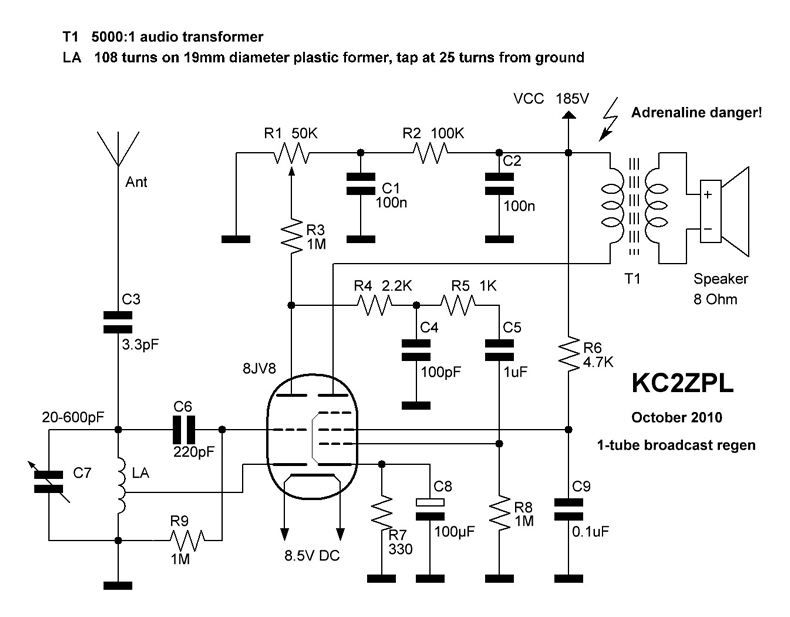
an advanced web server with a microcrontroller
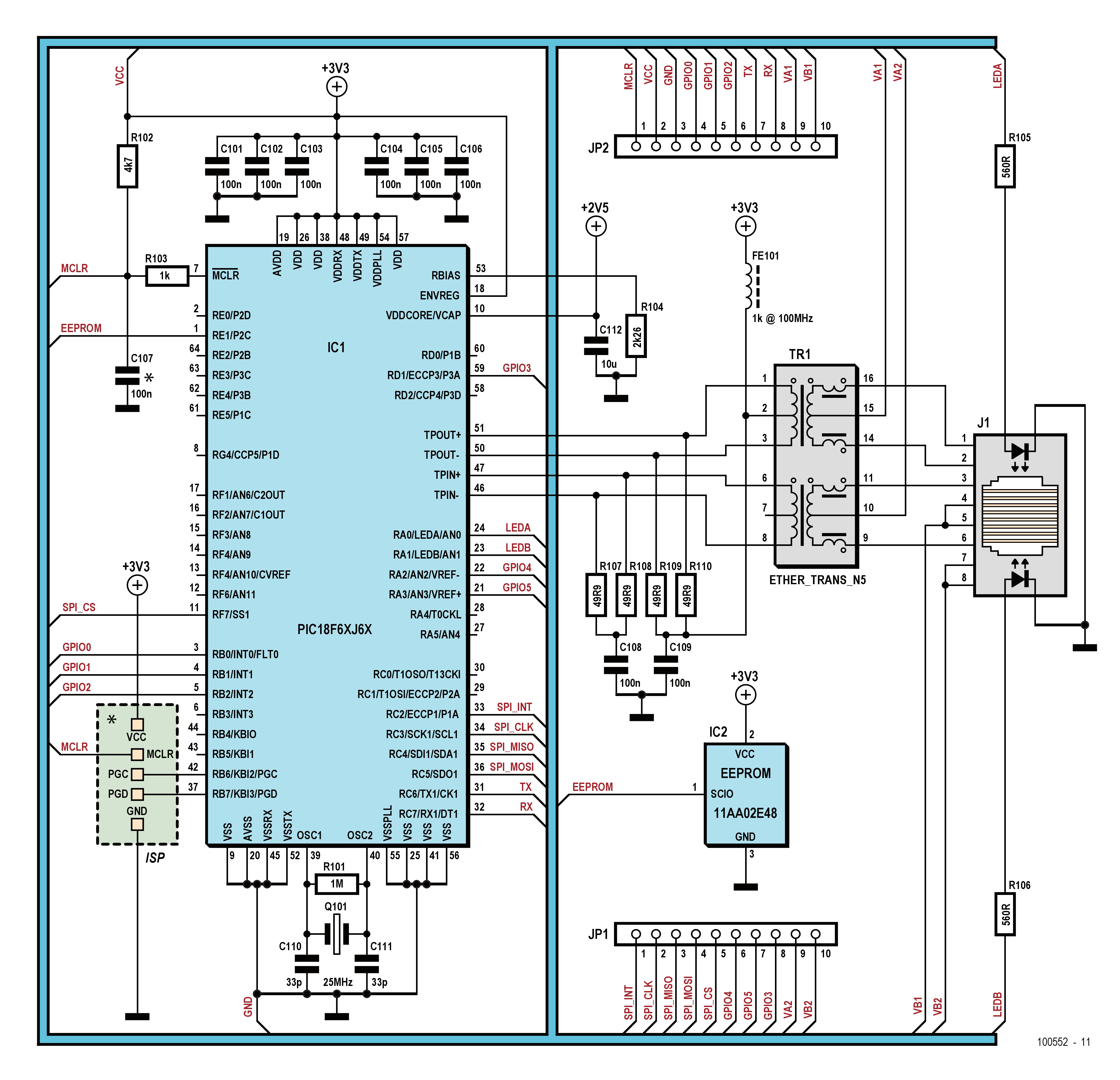
An Internet connection would significantly enhance many projects; however, designers are often deterred by the associated complexities. The NetWorker, which includes a small printed circuit board, a free software library, and a ready-to-use microcontroller-based web server, addresses these challenges and enables beginners to integrate Internet connectivity into their projects. More experienced users will find advantages in features such as SPI communications and Power over Ethernet (PoE). Connecting a device to an Ethernet network involves three essential components: the Ethernet connection hardware, the software library (known as the stack) that manages the various protocol layers, and the top-level firmware functions. For instance, a small web server running on a microcontroller can facilitate global access to a device. Compact, pre-made modules are commercially available to handle the first two elements, allowing microcontrollers to connect to a network without delving into the intricate details of the protocols. However, programming with the provided libraries can be challenging for beginners, while more experienced users often need to modify the firmware associated with the module. The solution presented here simplifies the complexity of network protocols for application programmers and is easily extensible and versatile. The circuit is built around a Microchip PIC18-family microcontroller that features an integrated Ethernet transceiver. The author has enhanced the free C software library from the manufacturer to implement the TCP/IP stack. The final component of the project is a web server operating on the microcontroller, which can communicate with other hardware through the device's I/O pins. This design allows for the rapid assembly of a small system that can be controlled over the Internet. Additionally, the module can function as a network modem for another microcontroller. Advanced features such as PoE enhance the project further. Printed circuit boards and pre-programmed microcontrollers are available from Elektor, along with the complete ready-made module. The accompanying software can also be downloaded for free from the Elektor website. The module's operation is illustrated in Figure 1 below. The core of the unit is a Microchip PIC18F67J60, part of a family of microcontrollers that includes a 10BASE-T Ethernet transceiver. Most required circuitry is integrated into the device, with only a few external components (including a connector) necessary for network connection. The Ethernet PICs require a 2.5 V core voltage supply, which can be derived from a higher voltage (3.3 V is recommended) using the built-in voltage regulator. The ENVREG pin determines the regulator's status. A 10 µF capacitor (C112) provides smoothing, while capacitors C101 to C106 decouple the supplies around the microcontroller. A 25 MHz crystal (Q101) supplies an external clock for the microcontroller, with the Ethernet transceiver clock also sourced from this. The project incorporates a bootloader that allows new firmware to be uploaded via the Ethernet interface. Alternatively, the device can be programmed through the solder pads MCLR, VCC, GND, PGD, and PGC, which constitute the standard Microchip in-circuit serial programming (ICSP) interface. This interface is essential for debugging software issues or when the module becomes unresponsive. A dedicated programmer, such as the ICD2, is necessary for debugging and programming through this interface. The reset circuit consists of R102, R103, and C107, where R102 acts as a pull-up resistor, and R103 and C107 serve to filter signals.
The NetWorker module provides an accessible solution for integrating Ethernet connectivity into various electronic projects. Its design minimizes the complexity associated with network protocols, making it suitable for both novice and experienced developers. The Microchip PIC18F67J60 microcontroller at the core of the circuit not only simplifies the hardware requirements but also allows for efficient communication over Ethernet through its built-in transceiver. The inclusion of a bootloader enhances the module's functionality by enabling firmware updates without the need for physical access to the device, thus facilitating remote updates and maintenance.
The printed circuit board (PCB) layout should ensure that the capacitors used for decoupling and smoothing are placed close to the microcontroller to minimize noise and improve power integrity. The choice of a 25 MHz crystal oscillator is critical, as it governs the timing for both the microcontroller and the Ethernet transceiver, ensuring reliable data transmission. The design also considers the power supply requirements, emphasizing the use of a 3.3 V supply for optimal performance, with appropriate voltage regulation to maintain stability.
For developers looking to extend the module's capabilities, the SPI communications feature can be utilized to connect additional peripherals, enhancing the overall functionality of the system. Furthermore, the availability of the free C software library facilitates rapid development and prototyping, allowing users to focus on application-specific features rather than underlying protocol intricacies.
In summary, the NetWorker module represents a robust platform for adding Internet connectivity to electronic projects, combining ease of use with advanced features that cater to a wide range of users, from beginners to seasoned professionals. The comprehensive design approach ensures that the module can be seamlessly integrated into various applications, promoting innovation and connectivity in modern electronic systems.An Internet connection would be a valuable addition to many projects, but often designers are put off by the complexities involved. The NetWorker`, which consists of a small printed circuit board, a free software library and a ready-to-use microcontroller-based web server, solves these problems and allows beginners to add Internet connectivity to
their projects. More experienced users will benefit from features such as SPI communications, power over Ethernet (PoE) and more. There are three key elements in connecting a device to an Ethernet network: the Ethernet connection hardware itself, the software library (called the stack`) responsible for handling the various protocol layers, and finally the top-level firmware functions.
For example, to allow access to a device from anywhere in the world, it is possible to use a small web server running in a microcontroller. Compact ready-made modules are available on the market to cover the first two of these elements. They allow you to connect a microcontroller to a network without having to get involved in the gritty details of its protocols.
However, programming against the libraries provided can be a daunting task for the beginner; and more experienced users often find it necessary to work around` the firmware provided with the module to enhance or modify it. The solution provided here hides the complexity of the network protocols from the application programmer, and is simple to extend and very versatile.
The circuit is based around a Microchip PIC18-family microcontroller which includes a built-in Ethernet transceiver. The author has added a few new functions to the free C software library available from the manufacturer that implements the TCP/IP stack.
The final element of the project is a web server running on the microcontroller which can communicate with other hardware via the I/O pins of the device. Using this design it is possible to assemble a small system in just a few minutes, capable of being controlled at will over the Internet.
Beyond that, the module can be used as a network modem` for another microcontroller. Extra advanced features such as PoE round out the project. Printed circuit boards and ready-programmed microcontrollers are available from Elektor, as well as the complete readymade module. And of course the accompanying software is also available as a free download from the Elektor website.
Now let`s see what makes the module tick. Figure 1 (below) shows the circuit of the module. At the heart of the unit is a Microchip PIC18F67J60. This device is one member of a range of microcontrollers that include a 10BASE-T Ethernet transceiver. Most of the circuitry required is provided in the device and only a few external components (including a connector!) are needed to connect to a network.
The Ethernet PICs require a 2. 5 V core voltage supply, which can be derived from a higher voltage (3. 3 V is recommended) using the voltage regulator included in the PIC. Pin ENVREG determines whether the voltage regulator is enabled. A 10 F capacitor (C112) provides smoothing and capacitors C101 to C106 positioned around the microcontroller decouple the supplies. A 25 MHz crystal (Q101) provides an external clock for the microcontroller, and the Ethernet transceiver clock is also derived from this source.
The project includes a bootloader which allows new firmware to be uploaded over the Ethernet interface. Alternatively the device can be programmed via the solder pads MCLR, VCC, GND, PGD and PGC which form the standard Microchip in-circuit serial programming (ICSP) interface.
This interface is needed for debugging software problems or if the module gets into a state where it no longer responds to being rebooted. A dedicated programmer (such as the ICD2) is required for debugging and programming over this interface.
The reset circuit comprises R102, R103 and C107. R102 is a pull-up resistor, and R103 and C107 filter 🔗 External reference
The NetWorker module provides an accessible solution for integrating Ethernet connectivity into various electronic projects. Its design minimizes the complexity associated with network protocols, making it suitable for both novice and experienced developers. The Microchip PIC18F67J60 microcontroller at the core of the circuit not only simplifies the hardware requirements but also allows for efficient communication over Ethernet through its built-in transceiver. The inclusion of a bootloader enhances the module's functionality by enabling firmware updates without the need for physical access to the device, thus facilitating remote updates and maintenance.
The printed circuit board (PCB) layout should ensure that the capacitors used for decoupling and smoothing are placed close to the microcontroller to minimize noise and improve power integrity. The choice of a 25 MHz crystal oscillator is critical, as it governs the timing for both the microcontroller and the Ethernet transceiver, ensuring reliable data transmission. The design also considers the power supply requirements, emphasizing the use of a 3.3 V supply for optimal performance, with appropriate voltage regulation to maintain stability.
For developers looking to extend the module's capabilities, the SPI communications feature can be utilized to connect additional peripherals, enhancing the overall functionality of the system. Furthermore, the availability of the free C software library facilitates rapid development and prototyping, allowing users to focus on application-specific features rather than underlying protocol intricacies.
In summary, the NetWorker module represents a robust platform for adding Internet connectivity to electronic projects, combining ease of use with advanced features that cater to a wide range of users, from beginners to seasoned professionals. The comprehensive design approach ensures that the module can be seamlessly integrated into various applications, promoting innovation and connectivity in modern electronic systems.An Internet connection would be a valuable addition to many projects, but often designers are put off by the complexities involved. The NetWorker`, which consists of a small printed circuit board, a free software library and a ready-to-use microcontroller-based web server, solves these problems and allows beginners to add Internet connectivity to
their projects. More experienced users will benefit from features such as SPI communications, power over Ethernet (PoE) and more. There are three key elements in connecting a device to an Ethernet network: the Ethernet connection hardware itself, the software library (called the stack`) responsible for handling the various protocol layers, and finally the top-level firmware functions.
For example, to allow access to a device from anywhere in the world, it is possible to use a small web server running in a microcontroller. Compact ready-made modules are available on the market to cover the first two of these elements. They allow you to connect a microcontroller to a network without having to get involved in the gritty details of its protocols.
However, programming against the libraries provided can be a daunting task for the beginner; and more experienced users often find it necessary to work around` the firmware provided with the module to enhance or modify it. The solution provided here hides the complexity of the network protocols from the application programmer, and is simple to extend and very versatile.
The circuit is based around a Microchip PIC18-family microcontroller which includes a built-in Ethernet transceiver. The author has added a few new functions to the free C software library available from the manufacturer that implements the TCP/IP stack.
The final element of the project is a web server running on the microcontroller which can communicate with other hardware via the I/O pins of the device. Using this design it is possible to assemble a small system in just a few minutes, capable of being controlled at will over the Internet.
Beyond that, the module can be used as a network modem` for another microcontroller. Extra advanced features such as PoE round out the project. Printed circuit boards and ready-programmed microcontrollers are available from Elektor, as well as the complete readymade module. And of course the accompanying software is also available as a free download from the Elektor website.
Now let`s see what makes the module tick. Figure 1 (below) shows the circuit of the module. At the heart of the unit is a Microchip PIC18F67J60. This device is one member of a range of microcontrollers that include a 10BASE-T Ethernet transceiver. Most of the circuitry required is provided in the device and only a few external components (including a connector!) are needed to connect to a network.
The Ethernet PICs require a 2. 5 V core voltage supply, which can be derived from a higher voltage (3. 3 V is recommended) using the voltage regulator included in the PIC. Pin ENVREG determines whether the voltage regulator is enabled. A 10 F capacitor (C112) provides smoothing and capacitors C101 to C106 positioned around the microcontroller decouple the supplies. A 25 MHz crystal (Q101) provides an external clock for the microcontroller, and the Ethernet transceiver clock is also derived from this source.
The project includes a bootloader which allows new firmware to be uploaded over the Ethernet interface. Alternatively the device can be programmed via the solder pads MCLR, VCC, GND, PGD and PGC which form the standard Microchip in-circuit serial programming (ICSP) interface.
This interface is needed for debugging software problems or if the module gets into a state where it no longer responds to being rebooted. A dedicated programmer (such as the ICD2) is required for debugging and programming over this interface.
The reset circuit comprises R102, R103 and C107. R102 is a pull-up resistor, and R103 and C107 filter 🔗 External reference
